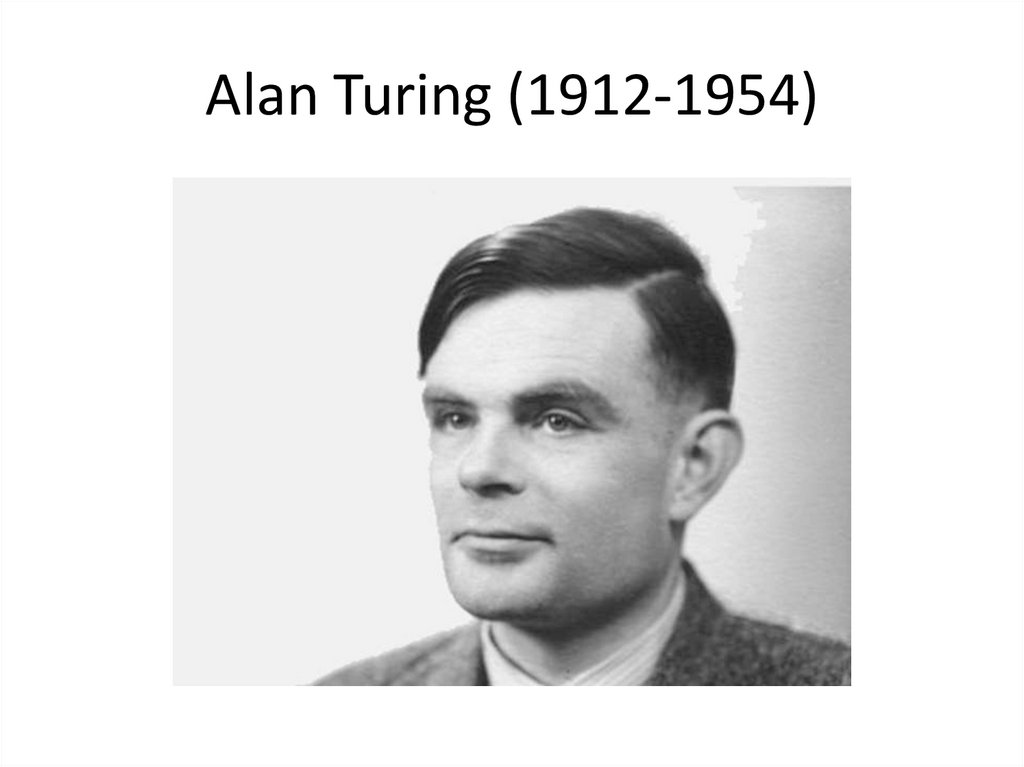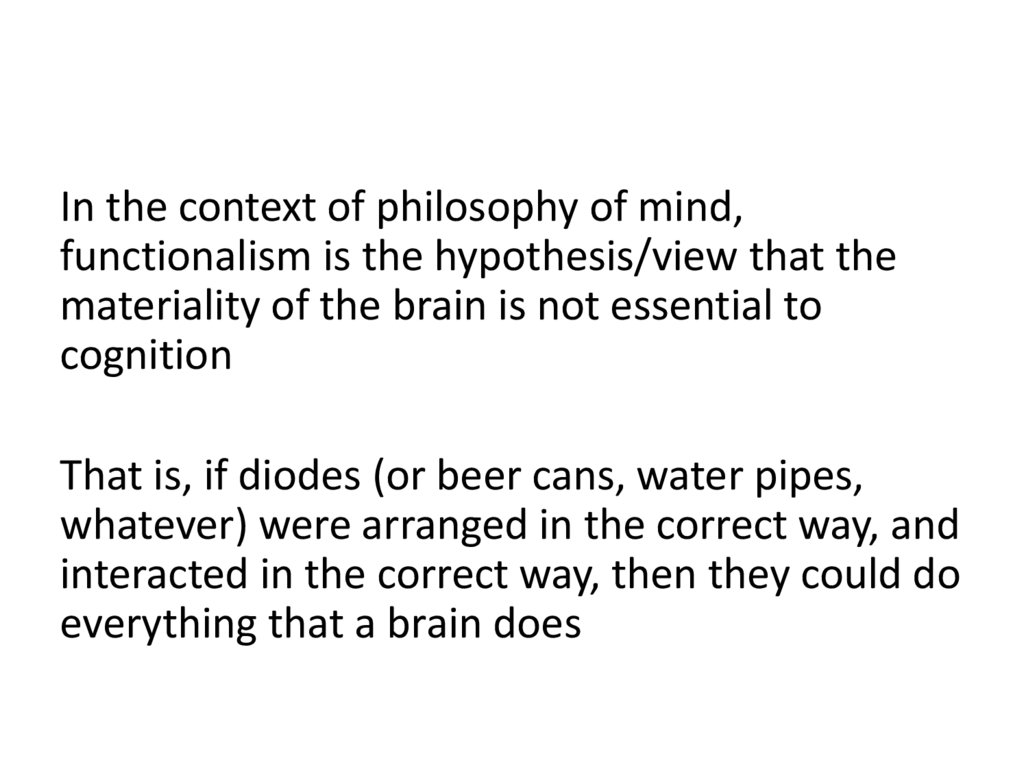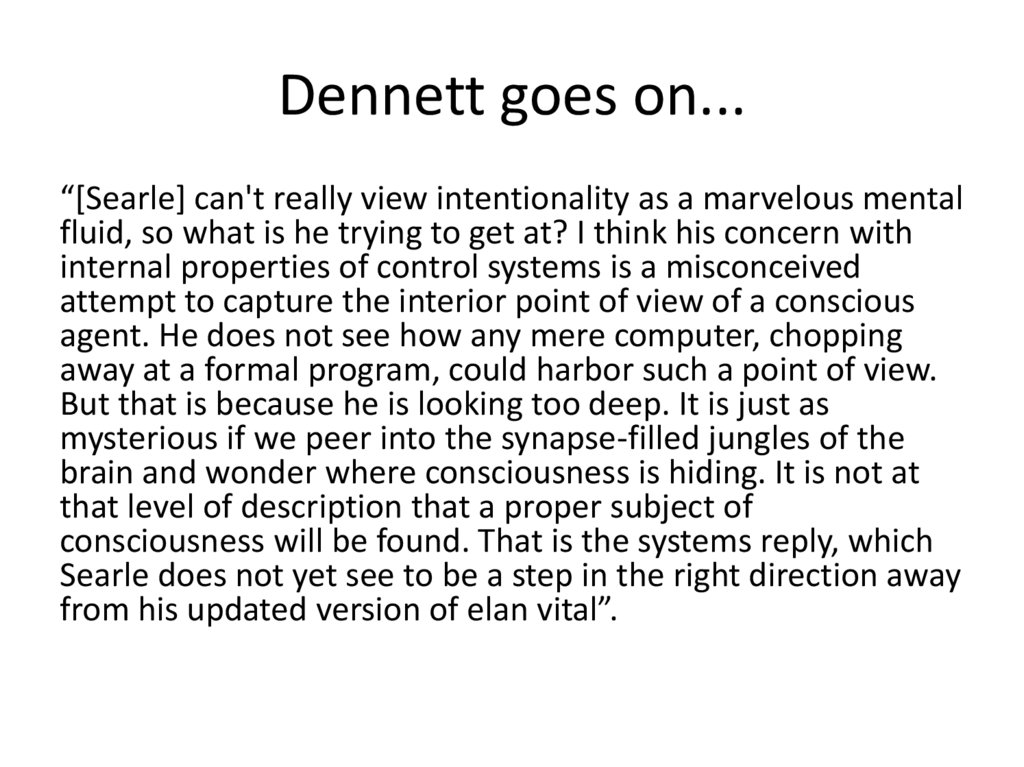Similar presentations:
Symbol Manipulation and Intentionality
1. Symbol Manipulation and Intentionality
2. Minds, Brains, and Programs
• Searle is addressing a few different butinterconnected issues
• One is the relationship between symbol
manipulation and intentionality
• Another is functionalism
• Another is the difference between “strong AI” and
“weak AI”
• Another is work that was being done in artificial
intelligence around the time the article was
published
• (Let’s look at this work first.)
3. Terry Winograd’s SHRDLU (1971)
Terry Winograd was a grad student at MITwhose dissertation project involved creating a
“blocks world” (i.e., a small, digital world of
shapes)
A human user, using natural language
expressions, could ask the computer about the
world and could command the computer to
manipulate the world
4. original
5. colored rendering
6. SHRDLU could...
• Describe (when asked) what was in the world(e.g., is there a green triangle on top of a box)
• Move things around (e.g., put a triangle on a
box)
• Answer questions about what was possible or
not (e.g., can you put a triangle on a triangle?)
7. conversation
Person: WHICH CUBE IS SITTING ON THE TABLE?Computer: THE LARGE GREEN ONE WHICH SUPPORTS
THE RED PYRAMID.
Person: IS THERE A LARGE BLOCK BEHIND A PYRAMID?
Computer: YES, THREE OF THEM: A LARGE RED ONE, A
LARGE GREEN CUBE, AND THE BLUE ONE.
Person: PUT A SMALL ONE ONTO THE GREEN CUBE
WHICH SUPPORTS A PYRAMID.
Computer: OK. (does it)
Person: PUT THE LITTLEST PYRAMID ON TOP OF IT.
Computer: OK. (does it)
8. you can see how predicate logic is useful here
Person: IS THERE A LARGE BLOCK BEHIND APYRAMID?
To answer the question, you ask whether the
following is true: “There is a large block behind a
pyramid.”
How would you translate that sentence into
predicate logic?
9. Roger Shank’s work
• Developed a software program that could answersimple questions about a story
• To illustrate the issues, Searle gives the following
example:
“A man went into a restaurant and ordered a
hamburger. When the hamburger arrived it was
burned to a crisp, and the man stormed out of the
restaurant angrily, without paying for the hamburger
or leaving a tip.”
10. Did the man eat the hamburger?
11.
We’re not told this information, but in the 1970sthere was work on “case-based reasoning” by
Roger Schank (and others) that allowed
computers to answer questions like this.
In short, the program “knows” how a sequence
of events would naturally unfold, and then
might be cued in to deviations from that
occurring.
12. Enthusiasts of AI thought we were starting to build computers that could think and understand.
13. This is very much related to the Turing Test
14. Alan Turing (1912-1954)
15. Alan Turing (1912-1954)
16. “Computing Machinery and Intelligence” (1950)
Imagine you have one person who is askingquestions of both a computer and a real person.
(Variant of the “imitation game.”)
If the person asking the questions can’t tell which is
the computer and which is the real person, then the
computer passes there Turing test
(There are other formulations of the Turing test, but
the basic idea is always the same.)
17.
There’s been a good deal of discussion about whatpassing the Turing test would actually accomplish.
Is passing the test really sufficient for saying a
machine can think?
There is also the charge of operationalism here, that
is, to “think” is just to be capable of passing the
Turing test
18. Daniel Dennett on a “great city”
19. a great city is one in which one can:
• have a nice French meal• go to the opera
• see a Rembrandt
20.
Dennett’s point is that clearly we should takethis as evidence for a city’s being great, not a
definition of a city’s being great
After all, we could have a city with one
Rembrandt, one French chef, and one orchestra,
but is terrible otherwise (e.g., in the midst of a
civil war, disease outbreaks, looting, etc.)
21. Let’s get to Searle’s Chinese Room
22. First, what is “intentionality”?
23. “aboutness”
• Comes from the Latin “intendere”, “to pointat”
• E.g., your belief that there’s a staircase outside
the door has intentionality because it is about
something, namely, the staircase
• Beliefs, desires, and goals have intentionality
• Not all mental states do (e.g., undirected
anxiety, depression)
24. And what is “functionalism”?
25.
In the context of philosophy of mind,functionalism is the hypothesis/view that the
materiality of the brain is not essential to
cognition
That is, if diodes (or beer cans, water pipes,
whatever) were arranged in the correct way, and
interacted in the correct way, then they could do
everything that a brain does
26.
And the idea here is that a neuron fires (ordoesn’t) which influences the probability that
some other neuron will fire (or won’t)
So if we replace each neuron in your brain with
any object that fired (or didn’t) and influenced
whether some other object would fire (or not),
then it would replicate the thinking, and
experience, of your own brain
27.
Often in cognitive science you here the minddescribed as “software” and the brain as
“hardware”.
A functionalist believes that what the hardware
is made out of is unimportant; all that matters is
what it does.
28. functionalism is controversial
• Most cognitive scientists endorse it (I think)• Most people working on AI do, too
• With philosophers of mind, it’s mixed (e.g.,
Searle clearly rejects it)
29. Ned Block’s “Troubles with Functionalism” (1978)
30. The China Brain Thought Experiment
No relationship to the Chinese Room, aside frombeing another thought experiment against
functionalism
China was chosen because it has the biggest
population of any country on earth
This isn’t exactly how Block’s thought experiment
worked, but it’s more relevant to the present
discussion...
31.
Suppose that China has 100 billion people, and thatwe give each person a little hand-held machine that
beeps when you press a button. And we also hook
up electrodes to each neuron in some person’s
brain (mine, say) and measure whether that neuron
is firing or not over the course of 5 seconds. Over
that 5 second period, I will of course have some
phenomenal (i.e., subjective) experience. If we
instruct the population of China to mimic the firing
of my neurons with their little machines, will the
nation of China have the same phenomenal
experience I had?
32.
Ned Block says clearly it will not. So he believesfunctionalism is false.
33. What’s the difference between “strong” and “weak” AI?
34. Roughly...
• weak AI just uses computers to help usunderstand how the mind works
• strong AI is the idea that computers can
actually think, understand, or experience in
the way that humans can
35. The Chinese Room
• Searle (who knows no Chinese) is locked in aroom
• He has a bunch of Chinese symbols and a rule
book (written in English) that tells him how to
match certain Chinese symbols with others.
• Someone puts Chinese symbols into the room,
he checks the rule book for how to respond,
then produces a response.
36. The Chinese Room
37. Searle’s Conclusions
(1) Instantiating a computer program is notsufficient for intentionality
After all, Searle instantiates the program, but he
does not know what the Chinese symbols mean.
For him, the Chinese symbols are not “about”
anything.
(In this context, we can really treat “intentionality”
and “understanding” as synonymous.)
38. Searle’s Conclusions
(2) Functionalism is implausibleFunctionalism says that what matters are the
functional relationships between the parts of a
system, not their materiality. But since Searle, by
merely by running this program, doesn’t know
Chinese, the materiality of the brain must
matter.
39. Searle’s Conclusions
(2*) Strong AI is implausibleStrong AI is predicated on functionalism, and
functionalism is implausible, for the reasons
given in the previous slide.
40. Important to note
Searle does not say that machines can’t think.Indeed, he says the brain is a machine and can
surely think.
Rather, he says that a machine has to be sufficiently
like the brain in order to think.
See p. 422
41. A few things to note
There’s a reading of Searle (1980) according towhich he’s really refuting behaviorism, the idea
that what it is to know Chinese (say) is to
produce appropriate responses to stimuli.
Or another reading is that Searle (1980) simply
shows that passing the Turing Test should not be
treated as a sufficient condition for determining
whether a machine can think.
42. the “systems reply”
Perhaps Searle doesn’t know Chinese, but “theroom” (i.e., the whole “system” does)
43. Dennett seems to have this response
“Searle observes: ‘No one would suppose that we couldproduce milk and sugar by running a computer simulation of
the formal sequences in lactation and photosynthesis, but
where the mind is concerned many people are willing to
believe in such a miracle.’ I don't think this is just a curious
illustration of Searle's vision; I think it vividly expresses the
feature that most radically distinguishes his view from the
prevailing winds of doctrine. For Searle, intentionality is rather
like a wonderful substance secreted by the brain the way the
pancreas secretes insulin. Brains produce intentionality, he
says, whereas other objects, such as computer programs, do
not, even if they happen to be designed to mimic the inputoutput behavior of (some) brain.”
44. Dennett goes on...
“[Searle] can't really view intentionality as a marvelous mentalfluid, so what is he trying to get at? I think his concern with
internal properties of control systems is a misconceived
attempt to capture the interior point of view of a conscious
agent. He does not see how any mere computer, chopping
away at a formal program, could harbor such a point of view.
But that is because he is looking too deep. It is just as
mysterious if we peer into the synapse-filled jungles of the
brain and wonder where consciousness is hiding. It is not at
that level of description that a proper subject of
consciousness will be found. That is the systems reply, which
Searle does not yet see to be a step in the right direction away
from his updated version of elan vital”.
45. How does Searle respond?
46.
“My response to the systems theory is quite simple:let the individual internalize all of these elements of
the system. He memorizes the rules in the ledger
and the data banks of Chinese symbols, and he
does all the calculations in his head. The individual
then incorporates the entire system. There isn't
anything at all to the system that he does not
encompass. We can even get rid of the room and
suppose he works outdoors. All the same, he
understands nothing of the Chinese, and a fortiori
neither does the system, because there isn't
anything in the system that isn't in him” (419).
47. the “robot reply”
"Suppose we wrote a different kind of program fromSchank's program. Suppose we put a computer inside a
robot, and this computer would not just take in formal
symbols as input and give out formal symbols as output,
but rather would actually operate the robot in such a way
that the robot does something very much like perceiving,
walking, moving about, hammering nails, eating, drinking
- anything you like. The robot would, for example, have a
television camera attached to it that enabled it to 'see,’ it
would have arms and legs that enabled it to 'act,' and all
of this would be controlled by its computer 'brain.' Such a
robot would, unlike Schank's computer, have genuine
understanding and other mental states” (p. 420)
48. How does Searle respond?
49.
But the answer to the robot reply is that the addition of such"perceptual" and "motor" capacities adds nothing by way of
understanding, in particular, or intentionality, in general, to
Schank's original program. To see this, notice that the same
thought experiment applies to the robot case. Suppose that
instead of the computer inside the robot, you put me inside the
room and, as in the original Chinese case, you give me more
Chinese symbols with more instructions in English for matching
Chinese symbols to Chinese symbols and feeding back Chinese
symbols to the outside. Suppose, unknown to me, some of the
Chinese symbols that come to me come from a television
camera attached to the robot and other Chinese symbols that I
am giving out serve to make the motors inside the robot move
the robot's legs or arms. It is important to emphasize that all I
am doing is manipulating formal symbols: I know none of these
other facts. I am receiving "information" from the robot’s
"perceptual" apparatus, and I am giving out "instructions" to its
motor apparatus without knowing either of these facts. I am the
robot's homunculus, but unlike the traditional homunculus, I
don't know what's going on.
50. So does the Chinese Room thought experiment show that a computer could never “understand” human language?
51.
Pair off into groups of 3-4, and comes up withpossible responses to Searle (even if you agree
with Searle!)
That is, come up with possible reasons why the
thought experiment fails to show that a
computer can never understand language.



















































 informatics
informatics




